The global mobile animal inhalation anesthesia machine market is projected to reach USD 397.3 million by 2035, recording an absolute increase of USD 173.3 million over the forecast period. The market is valued at USD 224.0 million in 2025 and is set to rise at a CAGR of 6% during the assessment period. The overall market size is expected to grow by nearly 1.8X during the same period, supported by increasing veterinary care standardization and growing demand for portable anesthetic equipment. However, high equipment costs and maintenance requirements pose constraints on rapid adoption across smaller veterinary practices.
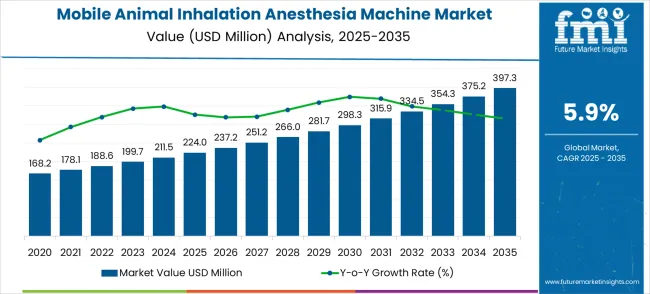
Between 2025 and 2030, the mobile animal inhalation anesthesia machine market is projected to expand from USD 224.0 million to USD 298.7 million, resulting in a value increase of USD 74.7 million, which represents 43.1% of the total forecast growth for the decade. This phase of growth will be shaped by rising demand for portable veterinary equipment, product innovation in anesthetic delivery systems and safety monitoring features, and expanding mobile veterinary services. Companies are establishing competitive positions through investment in advanced breathing circuits, strategic partnerships with veterinary clinics, and strategic market expansion across North America, Europe, and emerging Asian markets.
From 2030 to 2035, the market is forecast to grow from USD 298.7 million to USD 397.3 million, adding another USD 98.6 million, which constitutes 56.9% of the overall ten-year expansion. This period is expected to be characterized by expansion of specialized anesthetic solutions including multi-channel systems and advanced monitoring capabilities tailored for specific animal species, strategic collaborations between equipment manufacturers and veterinary education institutions, and technology integration with digital monitoring systems. The growing emphasis on animal welfare standards and veterinary practice modernization will drive demand for sophisticated anesthetic equipment across diverse veterinary and animal husbandry applications.
| Metric | Value |
|---|---|
| Market Value (2025) | USD 224 million |
| Market Forecast Value (2035) | USD 397.3 million |
| Forecast CAGR (2025-2035) | 6% |
The mobile animal inhalation anesthesia machine market expands through enabling precise anesthetic delivery and monitoring for veterinary procedures, reducing complications and improving patient outcomes across diverse animal species and surgical applications. Veterinary practice consolidation drives adoption as larger clinics implement standardized anesthetic protocols requiring reliable portable equipment. Mobile veterinary services integrate these machines to provide on-site surgical capabilities for farm animals and emergency procedures. Rising pet ownership and animal healthcare spending across developed markets accelerate equipment upgrades and new practice establishment. Advanced monitoring capabilities and safety features reduce anesthetic risks while meeting evolving animal welfare regulations. However, high initial equipment costs and specialized training requirements create adoption barriers for smaller veterinary practices with limited capital budgets.
The market is segmented by machine type, end-use, and region. By machine type, the market is divided into single channel, dual channel, and four channel systems. By end-use, the market is categorized into veterinary medical, animal husbandry, research laboratories, and others. Regionally, the market is divided into North America, Latin America, Europe, East Asia, South Asia & Pacific, and Middle East & Africa.
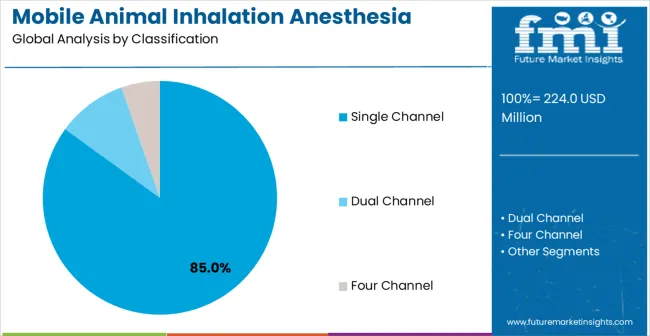
Single channel anesthesia machines are projected to account for 85% of the mobile animal inhalation anesthesia machine market in 2025. This share is supported by cost-effectiveness and operational simplicity that appeals to veterinary practices requiring reliable anesthetic delivery without complex multi-patient capabilities. Single channel systems provide adequate anesthetic control for most veterinary procedures while maintaining portability characteristics essential for mobile veterinary services. The segment enables veterinary practitioners to achieve consistent anesthetic depth management through straightforward operation protocols that reduce training requirements and operational complexity. These systems offer optimal balance between functionality and affordability for general veterinary practices performing routine surgical procedures across diverse animal species and body weights.
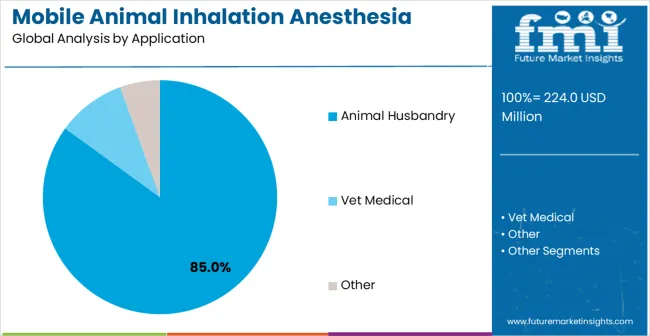
Animal husbandry applications are expected to represent 85% of mobile animal inhalation anesthesia machine demand in 2025. This dominant share reflects the extensive use of portable anesthetic equipment in livestock operations, dairy farms, and agricultural veterinary services requiring on-site surgical procedures and medical interventions. Animal husbandry facilities provide comprehensive anesthetic care for large animals including cattle, horses, sheep, and swine across routine procedures such as dehorning, castration, and emergency surgical interventions. The segment benefits from expanding livestock operations, increasing animal welfare standards, and growing demand for professional veterinary care in agricultural settings.
Mobile anesthetic equipment enables veterinary practitioners to deliver consistent anesthetic protocols across diverse farm environments while maintaining safety standards for both animals and operators. The portability characteristics of these machines support field veterinary services where transportation of large animals to clinical facilities would be impractical or stressful. Agricultural veterinary practices require reliable anesthetic equipment capable of operating in diverse environmental conditions while providing precise anesthetic delivery for animals of varying sizes and species.
Market growth stems from veterinary practice modernization requiring standardized anesthetic equipment, increasing pet ownership driving demand for veterinary services, and regulatory requirements for anesthetic safety monitoring improving patient care outcomes. These drivers create measurable outcomes including reduced anesthetic complications, improved surgical success rates, and enhanced veterinary practice efficiency through reliable equipment performance and consistent anesthetic delivery protocols.
Market expansion faces constraints from high equipment acquisition costs limiting adoption among smaller veterinary practices, specialized maintenance requirements necessitating technical expertise, and regulatory complexity surrounding anesthetic equipment validation across different jurisdictions. Alternative anesthetic delivery methods including injectable protocols and basic vaporizer systems compete for market share in cost-sensitive applications and emergency veterinary care settings.
Adoption accelerates in North American veterinary markets and European animal healthcare systems where practice consolidation and regulatory standardization support equipment upgrading and technology advancement. System designs shift toward integrated monitoring capabilities enabling real-time patient assessment and automated safety protocols. The growth thesis breaks if veterinary practice consolidation slows or alternative anesthetic technologies achieve comparable safety profiles at significantly lower equipment and operational costs.
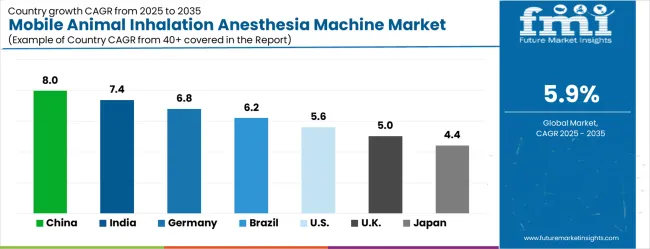
| Country | CAGR (2025-2035) |
|---|---|
| China | 8.0% |
| India | 7.4% |
| Germany | 6.8% |
| Brazil | 6.2% |
| United States | 5.6% |
| United Kingdom | 5.0% |
| Japan | 4.4% |
The mobile animal inhalation anesthesia machine market is gathering pace worldwide, with China taking the lead thanks to expanding veterinary infrastructure development and growing pet ownership trends. Close behind, India benefits from increasing animal husbandry modernization and government veterinary care initiatives, positioning itself as a strategic growth hub. Germany shows steady advancement, where advanced veterinary practice standards strengthen its role in the regional supply chain. Brazil is sharpening focus on livestock healthcare improvement and veterinary education expansion, signaling an ambition to capture niche opportunities. Meanwhile, United States stands out for its established veterinary care infrastructure, and United Kingdom and Japan continue to record consistent progress. Together, China and India anchor the global expansion story, while the rest build stability and diversity into the market's growth path.
The report covers an in-depth analysis of 40+ countries; seven top-performing countries are highlighted below.
China leads global mobile animal inhalation anesthesia machine adoption with comprehensive veterinary infrastructure development programs and extensive pet ownership growth initiatives supported by government investment exceeding $2.8 billion in animal healthcare modernization. Revenue growth at 8.0% CAGR through 2035 reflects deployment across veterinary clinics in Beijing, Shanghai, and Guangzhou, where portable anesthetic equipment supports expanding small animal practices and livestock healthcare programs. Chinese veterinary institutions implement standardized anesthetic protocols while domestic manufacturers develop cost-effective equipment solutions for local market requirements. Government programs promote veterinary education and practice modernization through technology incentives and infrastructure funding that facilitate anesthetic equipment adoption across urban and rural veterinary facilities.
In Mumbai, Delhi, and Bangalore, adoption of mobile animal inhalation anesthesia machines is accelerating across veterinary colleges implementing modern anesthetic training programs and livestock healthcare facilities expanding surgical capabilities. Government veterinary development programs promote animal healthcare infrastructure while private veterinary clinics adopt portable anesthetic equipment for mobile services. Revenue expansion at 7.4% CAGR through 2035 stems from animal husbandry sector growth and increasing veterinary education standards requiring modern equipment for training and clinical applications. Educational initiatives and technology transfer programs develop domestic capabilities for veterinary anesthetic equipment operation and maintenance across diverse animal species and clinical applications.
Germany maintains technological leadership in veterinary anesthetic equipment with comprehensive quality standards demonstrating equipment reliability rates exceeding 98% for clinical applications across diverse animal species. Hamburg, Munich, and Berlin serve as veterinary research centers where manufacturers optimize anesthetic delivery systems for small and large animal applications requiring precise monitoring capabilities. German veterinary equipment companies develop advanced anesthetic systems while veterinary clinics implement comprehensive anesthetic protocols supporting animal welfare requirements. The country's extensive veterinary research capabilities and manufacturing excellence facilitate equipment development and market approval processes across European Union markets. Technology advancement programs support innovation development through academic-industry partnerships and veterinary research funding initiatives. Revenue growth reaches 6.8% CAGR through 2035.
Brazilian veterinary facilities demonstrate growing adoption through livestock healthcare modernization programs requiring portable anesthetic equipment for large animal procedures and agricultural veterinary services. São Paulo, Rio de Janeiro, and Brasília emerge as veterinary development centers where anesthetic machines support expanding veterinary education programs and rural veterinary services. The market faces challenges from limited technical expertise requiring comprehensive training programs and budget constraints in agricultural veterinary applications. Growth potential stems from expanding livestock industry and increasing veterinary education standards that create demand for modern anesthetic equipment across agricultural and companion animal veterinary practices requiring reliable performance standards.
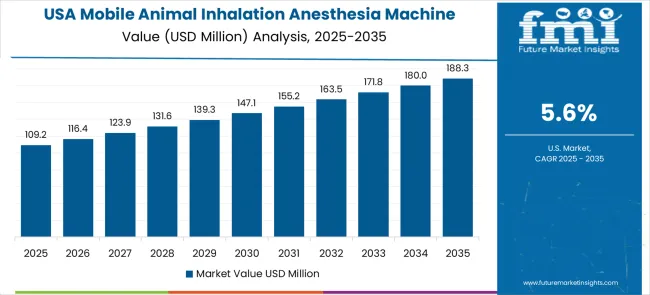
United States demonstrates market leadership through comprehensive veterinary care infrastructure and extensive companion animal healthcare spending supporting advanced anesthetic equipment adoption across veterinary practices. Revenue growth at 5.6% CAGR through 2035 reflects cost-per-outcome compression under compliance and reliability constraints as veterinary practices optimize anesthetic protocols through equipment standardization and safety monitoring integration. Boston, Los Angeles, and Houston serve as veterinary innovation centers where manufacturers develop specialized anesthetic solutions for companion animal and exotic animal applications. Government veterinary education funding supports equipment acquisition while veterinary associations maintain comprehensive anesthetic safety standards for clinical practice requirements.
United Kingdom develops comprehensive veterinary anesthetic applications through veterinary colleges implementing advanced training programs and veterinary practices adopting standardized anesthetic protocols for companion animal and livestock healthcare. London, Edinburgh, and Bristol serve as veterinary development centers where anesthetic equipment supports diverse veterinary education and clinical research programs.
Revenue expansion reflects veterinary practice modernization and government support for animal welfare standards requiring advanced anesthetic monitoring capabilities. The country's established veterinary research infrastructure facilitates equipment validation and clinical deployment through comprehensive testing and educational programs. Industry collaboration initiatives create sustained demand for advanced anesthetic technologies that enable precise anesthetic delivery and patient monitoring. Growth reaches 5.0% CAGR through 2035.
Japan focuses on high-precision anesthetic equipment manufacturing and system integration for demanding veterinary applications requiring superior reliability and performance characteristics across diverse animal species and clinical environments. Tokyo, Osaka, and Kyoto serve as veterinary technology development centers where manufacturers implement advanced quality control systems and precision engineering capabilities for specialized applications.
Japanese companies develop sophisticated anesthetic delivery systems and monitoring technologies that demonstrate superior performance in challenging clinical environments requiring exceptional accuracy and safety. The market benefits from extensive research capabilities and manufacturing excellence that support technology leadership in specialized veterinary applications. Revenue growth maintains steady advancement at 4.4% CAGR through 2035.
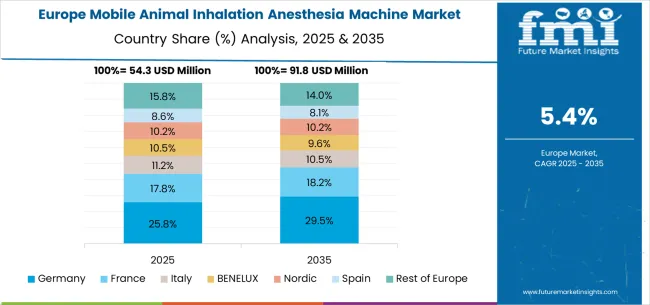
The European mobile animal inhalation anesthesia machine market reflects coordinated veterinary care advancement and animal welfare standardization across member states pursuing common regulatory frameworks and technology development objectives. Germany establishes technological leadership through comprehensive veterinary research capabilities and precision manufacturing expertise while maintaining focus on animal welfare standards and equipment quality. United Kingdom maintains veterinary education leadership through established veterinary colleges and clinical research programs despite market adjustments from regulatory changes.
France develops veterinary infrastructure through academic institutions and government programs supporting animal healthcare modernization across agricultural and companion animal sectors. Netherlands leverages agricultural expertise and veterinary research capabilities for livestock anesthetic applications and equipment development. Nordic countries emphasize animal welfare standards and veterinary practice modernization through government programs and regulatory initiatives supporting equipment standardization. The regional market benefits from harmonized veterinary standards and cross-border research collaboration that accelerate technology deployment and equipment validation across diverse veterinary applications and animal species.
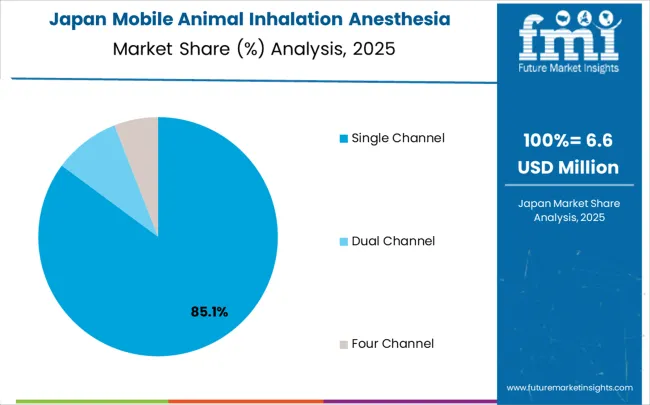
In Japan, the mobile animal inhalation anesthesia machine market is largely driven by the single channel machine segment, which accounts for 78% of total market revenues in 2025. The cost-effectiveness and operational simplicity of single channel systems make them essential for general veterinary practices performing routine procedures across companion animals and small livestock. Veterinary medical applications follow with a 65% share, primarily in companion animal clinics implementing standardized anesthetic protocols for surgical procedures. Animal husbandry contributes 25% through livestock veterinary services requiring portable anesthetic equipment for large animal procedures and emergency care. Research laboratory applications account for 10% as veterinary research institutions adopt anesthetic equipment for experimental procedures and clinical training programs.
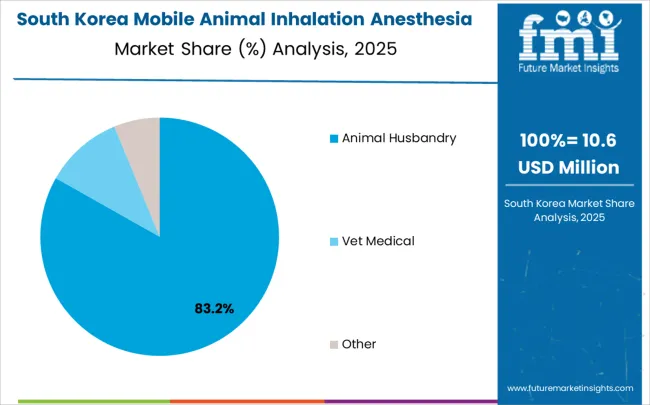
In South Korea, the market is expected to remain dominated by veterinary medical applications, which hold a 72% share in 2025. These facilities serve as primary deployment platforms for anesthetic equipment where companion animal procedures require reliable anesthetic delivery and patient monitoring capabilities. Animal husbandry and research laboratory applications each hold 18% and 10% market share respectively, with expanding adoption in livestock healthcare and veterinary research programs. The market benefits from government veterinary education initiatives and increasing pet ownership trends driving demand for advanced veterinary care services and modern anesthetic equipment across urban veterinary practices.
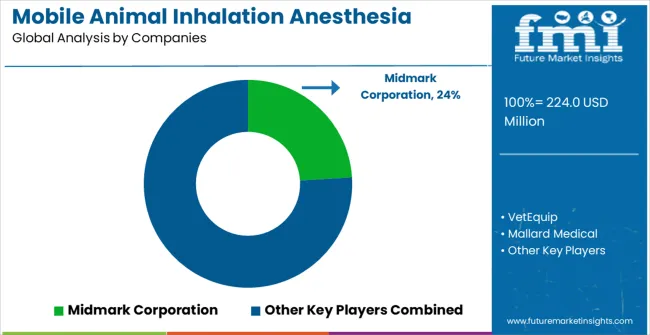
The mobile animal inhalation anesthesia machine market operates with moderate concentration among approximately 15-20 meaningful players, creating balanced competitive dynamics between established medical equipment manufacturers and specialized veterinary equipment providers. The top three companies control roughly 42% market share while the top five hold approximately 58%, indicating moderately fragmented competition with opportunities for market share expansion through technology differentiation and geographic expansion strategies. Competition emphasizes product reliability, portability optimization, and veterinary-specific features rather than aggressive pricing strategies that could compromise safety standards essential for veterinary anesthetic applications.
Market leaders leverage comprehensive veterinary equipment expertise, established veterinary practice relationships, and global distribution capabilities to maintain competitive positioning across diverse animal species and clinical environments. Midmark Corporation dominates through a broad veterinary equipment portfolio and extensive North American market presence, offering integrated anesthetic solutions that combine delivery systems with monitoring capabilities and veterinary practice management integration. VetEquip competes through specialized focus on veterinary anesthetic equipment and comprehensive technical support services, providing portable solutions optimized for mobile veterinary services and emergency applications. Mallard Medical maintains a strong position through high-quality equipment manufacturing and partnerships in veterinary education, developed over decades of specialization in veterinary anesthetic equipment.
Tier 2 challengers focus on specialized market segments, cost-competitive solutions, and regional manufacturing advantages to capture market share from established leaders. OMNI Scientific emphasizes precision anesthetic delivery and monitoring technologies, targeting advanced veterinary practices that require sophisticated equipment capabilities. Reward Life Science competes through innovative anesthetic system designs and veterinary practice integration capabilities, serving diverse clinical environments and the requirements of various animal species. Shanghai Olcott Biotechnology leverages Asian manufacturing capabilities and regional market knowledge to provide cost-effective solutions for emerging veterinary markets and budget-conscious practices.
Tier 3 specialized providers concentrate on regional markets, specific veterinary segments, or cost-sensitive applications where established players may have limited focus or competitive disadvantages. Companies including Shandong Defei Medical Technology, Shanghai TowerWang Intelligent Technology, Shanghai Jumu Medical Equipment, and Nanjing Calvin Biotechnology contribute manufacturing capacity and specialized expertise in Asian markets, particularly China's expanding veterinary sector. These suppliers compete through manufacturing cost advantages, local market knowledge, and the ability to serve specific veterinary requirements that may not align with global suppliers' strategic priorities or operational capabilities.
The mobile animal inhalation anesthesia machine market represents a specialized segment within veterinary medical equipment, projected to grow from $224.0 million to $397.3 million at a 6% CAGR. This equipment enables the safe and controlled delivery of anesthesia for diverse animal species across veterinary clinics, mobile veterinary services, and animal husbandry operations. The market is characterized by technical complexity requiring precise gas flow control, patient monitoring capabilities, and mobility features for field use. The regional distribution indicates a balanced global demand, with China leading at an 8.0% market share, followed by India at 7.4%. Success requires coordination across equipment manufacturers, veterinary practitioners, regulatory bodies, and technology developers to address species-specific anesthesia requirements and evolving animal welfare standards.
How Governments Could Enhance Veterinary Care Infrastructure?
Veterinary Equipment Grants: Establish funding programs for rural veterinary practices and mobile veterinary services to acquire advanced anesthesia equipment, improving animal care access in underserved agricultural regions and remote communities.
Regulatory Framework Development: Create comprehensive safety standards for mobile anesthesia equipment that address the unique challenges of field use, including vibration resistance, battery backup systems, and environmental durability for outdoor veterinary procedures.
Professional Training Support: Fund continuing education programs for veterinarians and veterinary technicians on advanced anesthesia techniques, species-specific protocols, and proper equipment maintenance to ensure safe anesthesia delivery across diverse animal populations.
Animal Welfare Compliance: Implement inspection and certification programs to ensure veterinary facilities maintain appropriate anesthesia equipment and protocols, particularly for livestock operations and research facilities that require consistent animal care standards.
Emergency Response Capabilities: Support mobile veterinary units equipped with portable anesthesia machines for disaster response, wildlife rescue operations, and emergency animal care situations requiring field anesthesia capabilities.
How Veterinary Associations Could Drive Professional Standards?
Anesthesia Protocol Standardization: Develop species-specific anesthesia guidelines that cover proper equipment selection, gas flow rates, monitoring parameters, and recovery protocols for various animal sizes and species across veterinary medicine and animal husbandry applications.
Equipment Certification Programs: Establish performance standards for mobile anesthesia machines that address critical parameters, including gas flow accuracy, pressure stability, ventilation capabilities, and mobility features essential for field veterinary work.
Training and Credentialing: Develop specialized certification programs for veterinary anesthesia, ensuring practitioners understand the operation of equipment, patient monitoring, and emergency procedures specific to mobile anesthesia delivery systems.
Safety Best Practices: Publish comprehensive safety guidelines addressing occupational exposure to anesthetic gases, proper ventilation requirements, and equipment maintenance protocols to protect veterinary personnel and ensure patient safety.
Technology Adoption Guidance: Provide evidence-based recommendations on selecting appropriate anesthesia equipment for various practice types, enabling veterinarians to choose between single-channel, dual-channel, and four-channel systems based on their caseload and species requirements.
How Equipment Manufacturers Could Advance Veterinary Anesthesia Technology?
Species-Specific Design: Develop anesthesia machines with adjustable parameters that accommodate the wide range of animal sizes, from small companion animals to large livestock, including specialized circuits and monitoring capabilities tailored to each species category.
Mobility Enhancement: Engineer lightweight, battery-powered systems with ruggedized construction suitable for mobile veterinary services, farm calls, and field operations while maintaining precise anesthesia delivery capabilities.
Integrated Monitoring Systems: Incorporate advanced patient monitoring, including pulse oximetry, capnography, blood pressure measurement, and temperature monitoring, specifically calibrated for veterinary applications across different animal species.
User Interface Optimization: Design intuitive control systems that enable rapid equipment setup and operation in field conditions, reducing complexity for veterinarians working in challenging environments with diverse animal patients.
Multi-Channel Flexibility: Develop modular systems that can operate as single-channel units for basic procedures or expand to dual-channel and four-channel configurations for complex surgeries and multi-animal procedures in research and production settings.
How Suppliers and Service Providers Could Support Market Growth?
Comprehensive Service Networks: Establish regional service capabilities covering equipment installation, preventive maintenance, emergency repairs, and calibration services to ensure consistent anesthesia machine performance across diverse veterinary applications.
Training and Support Programs: Provide hands-on training for veterinary staff on equipment operation, troubleshooting, and maintenance procedures, reducing downtime and ensuring optimal anesthesia delivery in critical situations.
Flexible Financing Solutions: Offer equipment leasing, rental programs, and flexible payment terms that enable smaller veterinary practices and mobile services to access advanced anesthesia technology without significant capital investment barriers.
Application-Specific Solutions: Develop targeted offerings for various market segments, including portable systems for mobile veterinarians, high-capacity units for animal husbandry operations, and specialized configurations for research facilities.
Parts and Consumables Management: Maintain a comprehensive inventory of replacement parts, breathing circuits, and consumables with rapid delivery capabilities, ensuring minimal service interruption for time-sensitive veterinary procedures.
How Investors and Financial Enablers Could Unlock Market Potential?
Technology Innovation Funding: Support R&D investments in next-generation anesthesia delivery systems, including improved gas mixing algorithms, enhanced patient monitoring capabilities, and advanced mobility features for field veterinary work.
Market Expansion Capital: Provide growth financing for manufacturers to expand production capacity, develop new product lines, and enter emerging markets where increasing animal healthcare awareness drives demand for advanced veterinary equipment.
Consolidation Opportunities: Enable strategic acquisitions that combine complementary technologies, expand geographic reach, or integrate vertical capabilities across the veterinary anesthesia equipment value chain.
Emerging Market Development: Fund market entry strategies in developing regions where growing livestock industries, expanding companion animal populations, and improving veterinary education create demand for mobile anesthesia equipment.
Service Infrastructure Investment: Support the development of comprehensive service networks, training facilities, and technical support capabilities that enable effective market penetration and customer satisfaction across diverse veterinary applications.
The mobile animal inhalation anesthesia machine market's 6% growth reflects an increasing emphasis on animal welfare, advancements in veterinary medical practices, and the expansion of mobile veterinary services. Success requires balancing technical sophistication with practical field requirements while addressing the diverse needs of companion animal medicine, livestock operations, and specialized veterinary applications across global markets.
| Item | Value |
|---|---|
| Quantitative Units | USD 224.0 million |
| Machine Type | Single Channel, Dual Channel, Four Channel |
| End-Use | Veterinary Medical, Animal Husbandry, Research Laboratories, Others |
| Regions Covered | North America, Latin America, Europe, East Asia, South Asia & Pacific, Middle East & Africa |
| Country Covered | United States, Canada, Germany, United Kingdom, France, China, Japan, South Korea, India, Brazil, Australia |
| Key Companies Profiled | Midmark Corporation, VetEquip, Mallard Medical, OMNI Scientific, Reward Life Science, Shanghai Olcott Biotechnology, Shandong Defei Medical Technology, Shanghai TowerWang Intelligent Technology, Shanghai Jumu Medical Equipment, Nanjing Calvin Biotechnology |
| Additional Attributes | Dollar sales by machine type and end-use segments, regional demand trends across North America, Europe, and Asia-Pacific, competitive landscape with established veterinary equipment manufacturers and specialized anesthetic system providers, buyer preferences for different channel configurations and monitoring capabilities, integration with veterinary practice management systems and patient monitoring technologies, innovations in anesthetic delivery and safety monitoring systems, and development of portable solutions with enhanced reliability capabilities for diverse veterinary applications. |
The global mobile animal inhalation anesthesia machine market is estimated to be valued at USD 224.0 million in 2025.
The market size for the mobile animal inhalation anesthesia machine market is projected to reach USD 397.3 million by 2035.
The mobile animal inhalation anesthesia machine market is expected to grow at a 5.9% CAGR between 2025 and 2035.
The key product types in mobile animal inhalation anesthesia machine market are single channel, dual channel and four channel.
In terms of application, animal husbandry segment to command 85.0% share in the mobile animal inhalation anesthesia machine market in 2025.






Our Research Products

The "Full Research Suite" delivers actionable market intel, deep dives on markets or technologies, so clients act faster, cut risk, and unlock growth.

The Leaderboard benchmarks and ranks top vendors, classifying them as Established Leaders, Leading Challengers, or Disruptors & Challengers.

Locates where complements amplify value and substitutes erode it, forecasting net impact by horizon

We deliver granular, decision-grade intel: market sizing, 5-year forecasts, pricing, adoption, usage, revenue, and operational KPIs—plus competitor tracking, regulation, and value chains—across 60 countries broadly.

Spot the shifts before they hit your P&L. We track inflection points, adoption curves, pricing moves, and ecosystem plays to show where demand is heading, why it is changing, and what to do next across high-growth markets and disruptive tech

Real-time reads of user behavior. We track shifting priorities, perceptions of today’s and next-gen services, and provider experience, then pace how fast tech moves from trial to adoption, blending buyer, consumer, and channel inputs with social signals (#WhySwitch, #UX).

Partner with our analyst team to build a custom report designed around your business priorities. From analysing market trends to assessing competitors or crafting bespoke datasets, we tailor insights to your needs.
Supplier Intelligence
Discovery & Profiling
Capacity & Footprint
Performance & Risk
Compliance & Governance
Commercial Readiness
Who Supplies Whom
Scorecards & Shortlists
Playbooks & Docs
Category Intelligence
Definition & Scope
Demand & Use Cases
Cost Drivers
Market Structure
Supply Chain Map
Trade & Policy
Operating Norms
Deliverables
Buyer Intelligence
Account Basics
Spend & Scope
Procurement Model
Vendor Requirements
Terms & Policies
Entry Strategy
Pain Points & Triggers
Outputs
Pricing Analysis
Benchmarks
Trends
Should-Cost
Indexation
Landed Cost
Commercial Terms
Deliverables
Brand Analysis
Positioning & Value Prop
Share & Presence
Customer Evidence
Go-to-Market
Digital & Reputation
Compliance & Trust
KPIs & Gaps
Outputs
Full Research Suite comprises of:
Market outlook & trends analysis
Interviews & case studies
Strategic recommendations
Vendor profiles & capabilities analysis
5-year forecasts
8 regions and 60+ country-level data splits
Market segment data splits
12 months of continuous data updates
DELIVERED AS:
PDF EXCEL ONLINE
Mobile Camping Toilet Market Size and Share Forecast Outlook 2025 to 2035
Mobile Phone Screen Underlayer Cushioning Material Market Size and Share Forecast Outlook 2025 to 2035
Mobile Application Store Market Size and Share Forecast Outlook 2025 to 2035
Mobile Money Market Forecast and Outlook 2025 to 2035
Mobile Application Testing Solution Market Size and Share Forecast Outlook 2025 to 2035
Mobile Cardiac Telemetry System Market Size and Share Forecast Outlook 2025 to 2035
Mobile Robots Market Size and Share Forecast Outlook 2025 to 2035
Mobile Crane Market Size and Share Forecast Outlook 2025 to 2035
Mobile Vascular Imaging Market Size and Share Forecast Outlook 2025 to 2035
Mobile Unified Communications and Collaboration (UC&C) Solution Market Size and Share Forecast Outlook 2025 to 2035
Mobile Data Protection Market Size and Share Forecast Outlook 2025 to 2035
Mobile Medical Tablets Market Size and Share Forecast Outlook 2025 to 2035
Mobile WLAN Access Points Market Size and Share Forecast Outlook 2025 to 2035
Mobile Social Networks Market Size and Share Forecast Outlook 2025 to 2035
Mobile Printer Market Size and Share Forecast Outlook 2025 to 2035
Mobile Application Development Platform Market Size and Share Forecast Outlook 2025 to 2035
Mobile Threat Management Security Software Market Size and Share Forecast Outlook 2025 to 2035
Mobile Broadband Infrastructure Market Size and Share Forecast Outlook 2025 to 2035
Mobile Enterprise Application Development Platform Market Size and Share Forecast Outlook 2025 to 2035
Mobile Analytics Market Size and Share Forecast Outlook 2025 to 2035

Thank you!
You will receive an email from our Business Development Manager. Please be sure to check your SPAM/JUNK folder too.
Chat With
MaRIA